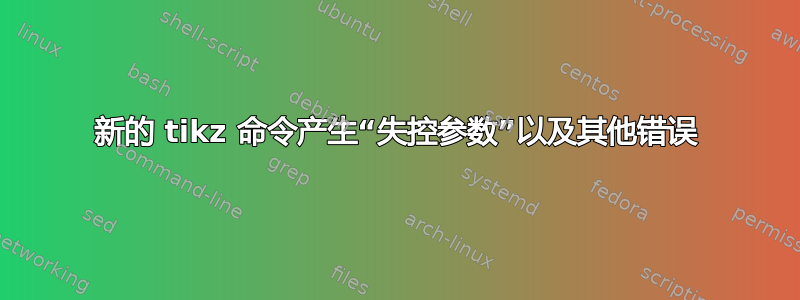
我正在尝试为 tikz 编写一个新命令,创建一个带有一些文本的侧向三角形(我将它用于模拟框图。它需要三个输入 - x 位置、y 位置和要放入其中的文本。(x,y)是三角形的左下角。当我运行代码时,它会爆炸。我得到了 16 个长错误,包括“失控参数”、“未知运算符‘$’”等等。
\documentclass{article}
\usepackage{tikz}
\newcommand{\analogblock}[3]{
\begin{tikzpicture}
\draw (#1, #2) -- (#1, 1);
\draw (#1, #2) -- (#1 + 1, #2/2);
\draw (#1, 1) -- (#1 + 1, #2/2);
\node[draw] at (#1 + #1/2,#2/2) {#3};
\end{tikzpicture}
}
\begin{document}
\begin{tikzpicture}
\analogblock{0,0, $-\int$}
\end{tikzpicture}
\end{document}
这里发生了什么?
输出的草图如下:
答案1
问题在于,多个参数宏的每个参数都应该用一对花括号括起来,而不是用逗号分隔:
\documentclass{article}
\usepackage{tikz}
\newcommand{\analogblock}[3]{
\begin{tikzpicture}
\draw (#1, #2) -- (#1, 1);
\draw (#1, #2) -- (#1 + 1, #2/2);
\draw (#1, 1) -- (#1 + 1, #2/2);
\node[draw] at (#1 + #1/2,#2/2) {#3};
\end{tikzpicture}
}
\begin{document}
\begin{tikzpicture}
\analogblock{0}{0}{$-\int$}
\end{tikzpicture}
\end{document}
如果由于某种原因您想要使用逗号分隔的宏,请尝试:
\documentclass{article}
\usepackage{tikz}
\def\analogblock#1{\analogblockhelper#1\nil}
\def\analogblockhelper#1,#2,#3\nil{%
\begin{tikzpicture}
\draw (#1, #2) -- (#1, 1);
\draw (#1, #2) -- (#1 + 1, #2/2);
\draw (#1, 1) -- (#1 + 1, #2/2);
\node[draw] at (#1 + #1/2,#2/2) {#3};
\end{tikzpicture}%
}
\begin{document}
\begin{tikzpicture}
\analogblock{0,0, $-\int$}
\end{tikzpicture}
\end{document}
答案2
如果您需要构建块来绘制某些方案,那么您应该考虑将它们绘制为节点或小图片\pic。使用节点比使用锚点有一些优势pic,但它们仅限于选定的节点形状。
此类构件的例子有:
\documentclass[tikz, margin=3mm]{standalone}
\usetikzlibrary{calc,
positioning,
shapes.geometric}
\newcommand\ppbb{path picture bounding box}
\tikzset{
shorten <>/.style = {shorten <=#1, shorten >=#1},
sx/.style = {xshift=#1 mm},
sy/.style = {yshift=#1 mm},
%---------------------------------------------------------------%
% ANP, parameter: #1: fill color %
%---------------------------------------------------------------%
amp/.style = {% amplifuer
shape=isosceles triangle, draw, fill=#1,
minimum width=12mm, minimum height=16mm,
inner sep=1mm, outer sep=0mm,
node contents={$-f$},
},% end of amp
amp/.default=white,
%---------------------------------------------------------------%
% Binary SUM, parameter: #1: fill color %
%---------------------------------------------------------------%
bsum/.style = {% Binary SUM
shape=rectangle, draw, fill=#1,
minimum size=6mm, align=center,
inner sep=1mm, outer sep=0mm,
path picture={%
\draw[thick,fill=white] (\ppbb.center) circle (2mm);
\draw[thick,shorten <>=1mm] (\ppbb.north) edge (\ppbb.south)
(\ppbb.west) -- (\ppbb.east);
},
node contents={},
},% end of cmp
bsum/.default=white,
%%-------------------------------------------------------------%%
% COMPARATOR %
%---------------------------------------------------------------%
cmp/.style = {% CoMParator
shape=rectangle, draw,
minimum height=12mm, text width=7mm, align=center,
inner sep=1mm, outer sep=0mm,
path picture={%
\draw[shorten <>=1mm] (\ppbb.west) edge (\ppbb.east)
(\ppbb.north) -- (\ppbb.south);
\draw[very thick] ([sx=+2,sy=-3] \ppbb.north) -| (\ppbb.center)
([sx=-2,sy=+3] \ppbb.south) -| (\ppbb.center);
},
node contents={},
},% end of cmp
%%-------------------------------------------------------------%%
% MULTIPLYING, parameters: #1: fill color %
%---------------------------------------------------------------%
mlt/.style={fill=#1,
rectangle, draw=black, minimum size=6mm,
path picture={\draw[very thick,shorten <>=1.5mm,-]
(\ppbb.north west) edge (\ppbb.south east)
(\ppbb.south west) -- (\ppbb.north east);
},% end of node contents
node contents={}},
mlt/.default = white,
%%-------------------------------------------------------------%%
% PHASE COMPARATOR, parameters: #1: fill color %
%---------------------------------------------------------------%
phc/.style={fill=#1,
circle, draw=black, minimum size=6mm,
path picture={\draw[very thick,-]
(\ppbb.north west) -- (\ppbb.south east)
(\ppbb.south west) -- (\ppbb.north east);
},% end of node contents
node contents={}},
phc/.default = white,
%%-------------------------------------------------------------%%
% SUM, parameters: #1: fill color %
%---------------------------------------------------------------%
sum/.style={fill=#1,
circle, draw=black, minimum size=6mm,
path picture={\draw[very thick,shorten <>=1mm,-]
(\ppbb.north) edge (\ppbb.south)
(\ppbb.west) -- (\ppbb.east);
},% end of node contents
node contents={}},
sum/.default = white,
}
\begin{document}
\begin{tikzpicture}[node distance=3mm]
\node (n1) [bsum];
\node (n2) [cmp, right=of n1];
\node (n3) [mlt, right=of n2];
\node (n4) [phc, right=of n3];
\node (n5) [sum, right=of n4];
\node (n6) [amp, right=of n5];
%
\draw (n6.east) -| ++ (1,1) -| ([sx=-10] n1.west) -- (n1);
\end{tikzpicture}
\end{document}
以及我评论中的示例,但现在使用append after command选项:
\documentclass[tikz, margin=3mm]{standalone}
\usetikzlibrary{arrows.meta, calc}
\begin{document}
\begin{tikzpicture}[
node distance= 5mm,
>= Straight Barb,
block/.style = {
rectangle, draw, thick,
minimum height=9mm, minimum width=12mm,
},
sat/.style = {block,
append after command={
\pgfextra{\let\LN\tikzlastnode
\draw[->] ($(\LN.south) + (0,0.5ex)$) edge ($(\LN.north) + (0,-0.5ex)$)
($(\LN.west) + (0.5ex,0)$) to ($(\LN.east) + (-0.5ex,0)$);
\draw[very thick, opacity=0.75]
($(\LN.south west) + (1ex,1ex)$) --
($(\LN.south) + (-1ex,1ex)$) --
($(\LN.north) + (1ex,-1ex)$) --
($(\LN.north east) + (-1ex,-1ex)$);
}% end \pgfextra
},% end after command
}
]
\node (X) [,sat] at (0,0) {};
\end{tikzpicture}
\end{document}
这使:





